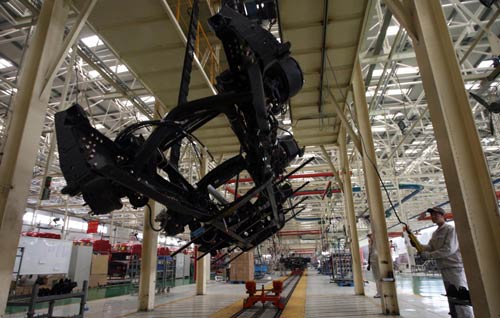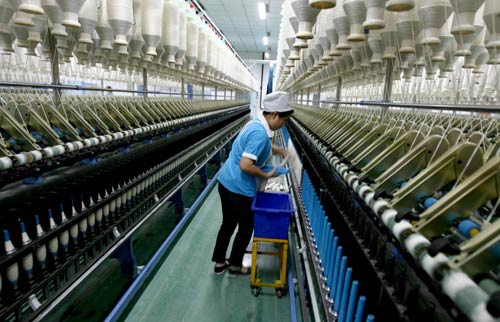Government and Policy
Shanxi prepares to diversify economy
Updated: 2010-12-14 07:55
By Wang Huazhong (China Daily)
BEIJING - North China's coal-rich Shanxi province got the go-ahead to break its dependence on resources and build a development model with diversified sectors.
The National Development and Reform Commission, the country's top economic planning body, said on Monday that it has approved the establishment of a "pilot economic transformation zone" in Shanxi to diversify the province's resource-dependent economy.
 |
|
Inside a workshop of an auto factory in Yuncheng, North China's Shanxi province, Dec 13, 2010. [Photo/Xinhua] |
Currently, coal, coke, fuel-generated electricity and metallurgy account for about 85 percent of Shanxi's industrial output, which relies heavily on demand from outside the province.
The goal of the pilot zone is to transform conventional industries and strike a balance among the agricultural, industrial and tertiary sectors in Shanxi, Peng Sen, deputy head of commission, said at a press conference organized by the State Council Information Office.
The zone is also designed to help Shanxi achieve green and sustainable development, bring about equal public services for rural and urban people, and set an example for other central and western regions, he said.
Zhang Xiaojing, a Beijing-based economist, said though Shanxi's resource-based economy is unique, the pilot zone will "tap experience to be spread across the country".
"Shanxi's economy is a microcosm of the Chinese economy. As China has been consuming more energy and resources, it has to prepare for a shortage of resources and achieve sustainable and eco-friendly development through economic structural reforms," Zhang said.
The Proposal for Formulating the 12th Five-Year Plan (2011-2015) for China's Economic and Social Development released in October does not include the usual target for GDP growth. Instead, it placed economic reform as a priority and paid greater attention to the adjustment of economic structure.
Niu Renliang, vice-governor of Shanxi, also said on Monday that the current Shanxi economic structure is not sustainable.
"Shanxi has powered the economic development of other regions, but with heavy economic, social and environmental consequences for itself."
Since 1949, Shanxi has produced 12 billion tons of coal, of which 75 percent was transported to other regions, said Niu.
This has resulted in Shanxi's dependence on external demand.
 |
|
A woman works at a textile factory in Yuncheng, North China's Shanxi province, Dec 13, 2010. [Photo/Xinhua] |
"During the Asian financial crisis in the late 1990s, Shanxi's economy faced great difficulties. In the international financial crisis in 2009, Shanxi was the slowest growing regional economy in China," he said.
Moreover, Liu said the resource-based economy exerts great pressure on safe mining, while wealth generated through the extensive exploitation has not benefited ordinary people financially in the province.
"I'm pleased that we have begun looking for a breakthrough and striving to turn the resource-based economy toward the road of sustainable development."
A spokesman for the Jinhuagong Coalmine, which is based in Datong city of Shanxi, said the leadership of his coalmine shares a common understanding with policymakers.
"Since 2000, we have realized that 50 million reserve tons of the Jinhuagong Coalmine will be depleted in the 2020s. We must think what our 8,000 workers will do for a living afterward."
He said the company began developing tourism services in 2003, when it welcomed people to an underground adventure tour.
The company later built a village to showcase folk culture and this year laid the foundation for China's first coalmine museum, he said.
E-paper

Ear We Go
China and the world set to embrace the merciful, peaceful year of rabbit
Preview of the coming issue
Carrefour finds the going tough in China
Maid to Order
Specials

Mysteries written in blood
Historical records and Caucasian features of locals suggest link with Roman Empire.

Winning Charm
Coastal Yantai banks on little things that matter to grow

New rules to hit property market
The State Council launched a new round of measures to rein in property prices.




